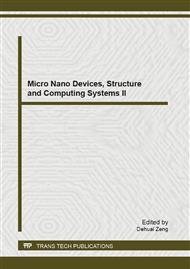p.55
p.61
p.69
p.74
p.79
p.85
p.90
p.94
p.98
Michelson Interferometer for near Infrared Wavelengths
Abstract:
This paper presents an architecture to simplify a Michelson Interferometer, designed with MEMS technology in order to obtain the near infrared wavelengths in the range of [1620-1800 nm], which will be used in a non-invasive micro sensor of glucose. The input interferometer is fed with a white light source. The poli-silicon, superficial and bulk processes are utilized to design the architecture. The interferometer is based on dividing the design into three parts formed by two gears, a zipper and two mirrors at 90° each of one, for achieving resolution improvement without decreasing mechanical resistance of the parts. Each part is modeled mathematically and their behavior is verified using different analysis in-SolidWorksTM. On the other hand, the beamsplitter of the Michelson Interferometer is placed at 45° with respect to mirrors. The simulation results demonstrate the validity of the behavior of interferometer proposed.
Info:
Periodical:
Pages:
79-84
Citation:
Online since:
March 2013
Keywords:
Price:
Сopyright:
© 2013 Trans Tech Publications Ltd. All Rights Reserved
Share:
Citation:


